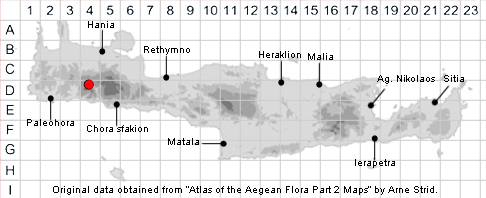SPECIES DESCRIPTION
RANUNCULUS LATERIFLORUS
Family and Genus:- See- RANUNCULACEAE/Sect. MICRANTHUS
Common Names:- None
Homotypic Synonyms:- None
Meaning:- Ranunculus (L) Little-frog, diminutive of rana, (reference to the water-
loving habit of many species).
Lateriflorus (L) With one-sided inflorescence.
General description:- Small, glabrous annual, often branched from the base,
sometimes rooting at the lower nodes.
Stems:-
1) 5-20 cm, ascending to erect, simple or subdichotomously branched.
Leaves:-
1) Lower;
a) petiole, 2-3 times as long as the lamina, dilated to a short, scarious, sheath
at the base;
b) lamina, 15-25 x 7-14 mm, elliptic, rounded, cuneate, at the base, crenate-
dentate, towards the apex, obtuse.
2) Upper cauline, similar but short-petiolate and narrower.
Flowers:-
1) Small, solitary and sessile in the leaf axils.
2) Sepals, 2-3 mm, elliptic-ovate, obtuse, ± scarious, caducous.
3) Petals, equalling the sepals, pale yellow, with a narrow claw and an ovate,
obtuse limb.
4) Receptacle, glabrous.
Fruit:-
1) Achene;
a) head, subglobose, c. 6 mm, on a very short, stout pedicel, persistent,
echinate, with c. 30 achenes.
b) body, of the achene c. 1.5 mm, broadly elliptic, compressed, tuberculate,
attenuate into a broad-based, almost straight beak c. 1.5 mm.
Key features:-
1) Flowers, small, solitary and sessile in the leaf axils.
2) Petals, equalling the sepals, pale yellow, with a narrow claw and ovate, obtuse
limb.
3) Body of the achene, gradually attenuate into a broad-based, almost straight
beak.
Habitat:- Muddy places by vernal pools, edge of shallow lakes, dolines, 0-1900 m.
Distribution:- Rare on mainland Greece. - Widely scattered in the Mediterranean
region and eastwards to C Asia. On Crete confined to the Omalos plain in Lefka Ori
Flowering time:- April to mid-July
Photos by:- Fotis Samaritakis

